|
|
| Sei in: Cinema e Medioevo ® Indice alfabetico dei film |
ROMEO E GIULIETTA
(Romeo and Juliet)
1968, regia di Franco Zeffirelli

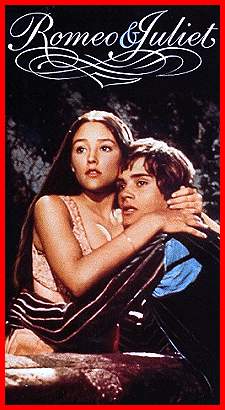
Scheda: Nazione: Italia-GB - Produzione: BHE Films, Dino de Laurentiis Cinematografica, Paramount Pictures, Verona Produzione - Distribuzione: Paramount, Cic Video - Soggetto: da Giulietta e Romeo di William Shakespeare - Adattamento e sceneggiatura: Franco Brusati, Maestro D'Amico, Franco Zeffirelli - Fotografia: Pasqualino De Santis - Montaggio: Reginald Mills - Scenografia: Lorenzo Mongiardino - Costumi: Danilo Donati - Musiche: Nino Rota - Formato: Technicolor - Durata: 138' (152').
Cast: Olivia Hussey, Leonard Whiting, John McEnery, Milo O'Shea, Pat Heywood, Robert Stephens, Michael York, Bruce Robinson, Paul Hardwick, Natasha Parry, Antonio Pierfederici, Esmeralda Ruspoli, Roberto Bisacco, Roy Holder, Keith Skinner, Murray Head, Dyson Lovell, Richard Warwick, Roberto Antonelli, Paola Tedesco, Carlo Palmucci.
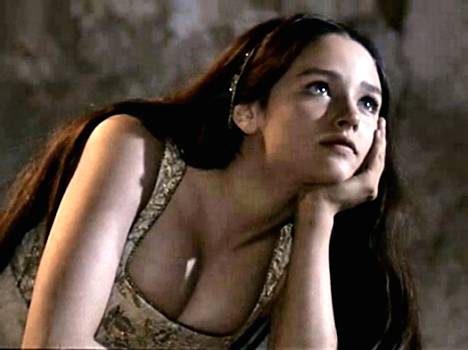
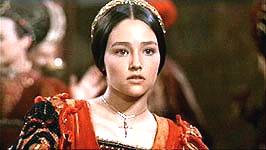

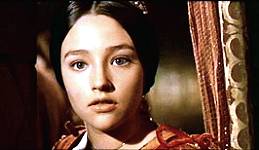
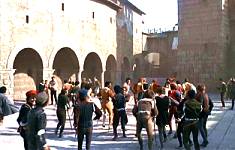
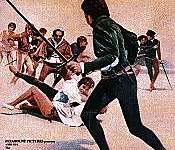
![]() clicca
sulle immagini in basso per ingrandirle
clicca
sulle immagini in basso per ingrandirle
![]() Trama e commenti: cinematografo.it
- kataweb.it
-
mymovies.it
- film.spettacolo.virgilio.it
- film.it
- it.movies.yahoo.com
- tempimoderni.com
- cinekolossal.com
- filmscoop.it
- it.wikipedia.org:
«Romeo e Giulietta è un film del 1968, diretto da Franco Zeffirelli; trasposizione cinematografica della celebre opera teatrale omonima di William Shakespeare, è un stato girato in lingua inglese, visti anche i numerosi interpreti stranieri.
Nel 1969 è stato nominato ai premi Oscar per le categorie "miglior film", "miglior regista", "migliori costumi" e "miglior fotografia", vincendo queste ultime due e 3 Gloden Globe ("miglior film straniero", "miglior giovane promessa femminile" a Olivia Hussey e "miglior giovane promessa maschile" a Leonard Whiting) e un BAFTA per i "migliori costumi".
Il film è stato adattato al grande schermo da Franco Brusati, Maestro D'Amico e dallo stesso regista Franco Zeffirelli, ed è noto per essere, oltre che tra le rappresentazioni più fedeli al testo scritto, una delle prime versioni dell'opera di Shakespeare in cui gli attori principali sono molto vicini all'età dei personaggi originali; infatti, durante le riprese Leonard Whiting (Romeo) aveva 17 anni, Olivia Hussey (Giulietta) 16.
A causa della scena di nudo tra i due e la minore età dei protagonisti, il film provocò qualche polemica, e il rating originale del film in Gran Bretagna e negli Stati Uniti fu "A", per adulti; infatti il regista Franco Zeffirelli, per mostrare il seno di Olivia Hussey in una scena, dovette ottenere un permesso speciale dalla censura italiana; alla stessa Hussey fu proibito entrare in sala per vedere il film perché ritenuto per adulti a causa della sua breve scena di nudo, e lei commentò su come fosse possibile che lei non potesse vedere qualcosa che "vedo nello specchio ogni giorno".
... Inizialmente a Paul McCartney fu chiesto di recitare la parte di Romeo...».
Trama e commenti: cinematografo.it
- kataweb.it
-
mymovies.it
- film.spettacolo.virgilio.it
- film.it
- it.movies.yahoo.com
- tempimoderni.com
- cinekolossal.com
- filmscoop.it
- it.wikipedia.org:
«Romeo e Giulietta è un film del 1968, diretto da Franco Zeffirelli; trasposizione cinematografica della celebre opera teatrale omonima di William Shakespeare, è un stato girato in lingua inglese, visti anche i numerosi interpreti stranieri.
Nel 1969 è stato nominato ai premi Oscar per le categorie "miglior film", "miglior regista", "migliori costumi" e "miglior fotografia", vincendo queste ultime due e 3 Gloden Globe ("miglior film straniero", "miglior giovane promessa femminile" a Olivia Hussey e "miglior giovane promessa maschile" a Leonard Whiting) e un BAFTA per i "migliori costumi".
Il film è stato adattato al grande schermo da Franco Brusati, Maestro D'Amico e dallo stesso regista Franco Zeffirelli, ed è noto per essere, oltre che tra le rappresentazioni più fedeli al testo scritto, una delle prime versioni dell'opera di Shakespeare in cui gli attori principali sono molto vicini all'età dei personaggi originali; infatti, durante le riprese Leonard Whiting (Romeo) aveva 17 anni, Olivia Hussey (Giulietta) 16.
A causa della scena di nudo tra i due e la minore età dei protagonisti, il film provocò qualche polemica, e il rating originale del film in Gran Bretagna e negli Stati Uniti fu "A", per adulti; infatti il regista Franco Zeffirelli, per mostrare il seno di Olivia Hussey in una scena, dovette ottenere un permesso speciale dalla censura italiana; alla stessa Hussey fu proibito entrare in sala per vedere il film perché ritenuto per adulti a causa della sua breve scena di nudo, e lei commentò su come fosse possibile che lei non potesse vedere qualcosa che "vedo nello specchio ogni giorno".
... Inizialmente a Paul McCartney fu chiesto di recitare la parte di Romeo...».
![]() Plot Summary, Synopsis, Review: IMDb - movies2.nytimes.com - entertainment.msn.com
- filmsite.org - students.ed.uiuc.edu -
tvguide.com:
«This beautiful version of the Veronese love story was by far the most successful at the box office, although Zeffirelli took a huge chance casting two unknowns in the leads. Whiting was 17 and Hussey was 15, the closest any screen actors have actually come to the ages of the characters. It's a visually stunning adaptation with much action, broad humor, and eroticism. The Italian director had made
The
Taming of the Shrew
the year before with Elizabeth Taylor and Richard Burton. Although that film was not a big hit, his backers felt that his assured direction merited another attempt at Shakespeare, and the project was filmed in Tuscany at Pienza, Gubbio, Artena, and in the palace once owned by the Borgias. In order to take the onus off the relatively inexperienced leads, Zeffirelli trimmed some of the longer speeches, used reaction shots to break matters up, and gave the actors bits of business to do so they wouldn't seem like talking heads. That technique...».
Plot Summary, Synopsis, Review: IMDb - movies2.nytimes.com - entertainment.msn.com
- filmsite.org - students.ed.uiuc.edu -
tvguide.com:
«This beautiful version of the Veronese love story was by far the most successful at the box office, although Zeffirelli took a huge chance casting two unknowns in the leads. Whiting was 17 and Hussey was 15, the closest any screen actors have actually come to the ages of the characters. It's a visually stunning adaptation with much action, broad humor, and eroticism. The Italian director had made
The
Taming of the Shrew
the year before with Elizabeth Taylor and Richard Burton. Although that film was not a big hit, his backers felt that his assured direction merited another attempt at Shakespeare, and the project was filmed in Tuscany at Pienza, Gubbio, Artena, and in the palace once owned by the Borgias. In order to take the onus off the relatively inexperienced leads, Zeffirelli trimmed some of the longer speeches, used reaction shots to break matters up, and gave the actors bits of business to do so they wouldn't seem like talking heads. That technique...».
![]() Approfondimenti: Movie
Review
Approfondimenti: Movie
Review
![]() La
recensione di Alessandro Giancipoli in "Le altre recensioni"
La
recensione di Alessandro Giancipoli in "Le altre recensioni"